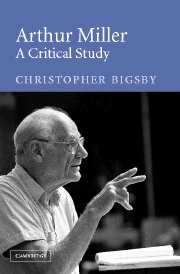Book contents
- Frontmatter
- Contents
- Acknowledgements
- Note on the text
- Introduction
- 1 The Michigan plays
- 2 The Golden Years, The Half-Bridge, Boro Hall Nocturne
- 3 The radio plays
- 4 The Man Who Had All the Luck
- 5 Focus
- 6 All My Sons
- 7 Death of a Salesman
- 8 Arthur Miller: time-traveller
- 9 An Enemy of the People
- 10 The Crucible
- 11 A Memory of Two Mondays
- 12 A View from the Bridge
- 13 Tragedy
- 14 The Misfits
- 15 After the Fall
- 16 Incident at Vichy
- 17 The Price
- 18 The Creation of the World and Other Business
- 19 The Archbishop's Ceiling
- 20 Playing for Time
- 21 The shearing point
- 22 The American Clock
- 23 The one-act plays: Two-Way Mirror, and Danger: Memory!
- 24 The Ride Down Mount Morgan
- 25 The Last Yankee
- 26 Broken Glass
- 27 Mr Peters' Connections
- 28 Resurrection Blues
- 29 Finishing the Picture
- 30 Fiction
- 31 Arthur Miller as a Jewish writer
- Notes
- Index
21 - The shearing point
Published online by Cambridge University Press: 16 November 2009
- Frontmatter
- Contents
- Acknowledgements
- Note on the text
- Introduction
- 1 The Michigan plays
- 2 The Golden Years, The Half-Bridge, Boro Hall Nocturne
- 3 The radio plays
- 4 The Man Who Had All the Luck
- 5 Focus
- 6 All My Sons
- 7 Death of a Salesman
- 8 Arthur Miller: time-traveller
- 9 An Enemy of the People
- 10 The Crucible
- 11 A Memory of Two Mondays
- 12 A View from the Bridge
- 13 Tragedy
- 14 The Misfits
- 15 After the Fall
- 16 Incident at Vichy
- 17 The Price
- 18 The Creation of the World and Other Business
- 19 The Archbishop's Ceiling
- 20 Playing for Time
- 21 The shearing point
- 22 The American Clock
- 23 The one-act plays: Two-Way Mirror, and Danger: Memory!
- 24 The Ride Down Mount Morgan
- 25 The Last Yankee
- 26 Broken Glass
- 27 Mr Peters' Connections
- 28 Resurrection Blues
- 29 Finishing the Picture
- 30 Fiction
- 31 Arthur Miller as a Jewish writer
- Notes
- Index
Summary
The Israeli writer, Joshua Sobol, in planning a play about the Holocaust, came across a slogan from the Wilna ghetto in Lithuania, in which over fifty thousand of the seventy thousand Jews were massacred. It read: ‘There can be no theatre in a graveyard.’
The Holocaust stands as an intimidating and disabling fact. For the writer, its sheer implacability is a challenge. The disproportion between event and its representation, between fact and the meaning of fact, leaves nothing but the stain of irony, a taste in the mouth that can find no equivalent beyond itself. Even for those who survived it, the Holocaust defied expression, understanding, belief. One of only two survivors of the Chelmo extermination camp returned to the place where he had once been forced to feed the crematorium ovens and tried to describe what he had experienced, what he had seen, for Claude Lanzmann's film Shoah. ‘There were’, he said, ‘two ovens and afterwards the bodies were thrown into those ovens, and the flames reached to the sky. It was terrible.’ Beyond that he could hardly go. As he said, ‘No one can describe it. No one can recreate what happened here. Impossible. And no one can understand it. Even I, here, now … I can't believe I'm here. No, I just can't believe it.’
For George Steiner, the world of Auschwitz lies ‘outside the normative syntax of human communication’. For Hannah Arendt it is inexpressible because it stands outside of life and death.
- Type
- Chapter
- Information
- Arthur MillerA Critical Study, pp. 325 - 336Publisher: Cambridge University PressPrint publication year: 2004



